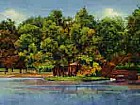
Landscapers
GRHC - August 4th, 2010
The influence of Paul Goebel, Sr., landscape designer, and sons
Transcript
When Prussian landscape artist and gardener Paul Goebel arrived in Grand Rapids in the mid 1880s he did what he knew best; he opened a greenhouse and florist business on Hall St. near Oak Hill Cemetery. His former employer had been the German Emperor William I; for three years Goebel was responsible for the royal gardens in Berlin and Potsdam.
His sons Frank, Eugene, Max, and Charles learned from their father, and participated in the landscape business one way or another. Goebel had also established a greenhouse in Wabash, Indiana, which was run by son Frank, who later became Superintendent of Grounds at the Michigan Soldier’s Home. Frank’s son, Paul G. Goebel, was elected mayor of Grand Rapids in 1950.
When Paul Goebel died in 1906 his wife Amelia and the youngest son, Charles, ran the florist business.
By this time Eugene had put his landscape knowledge to work as the superintendent of Oak Hill Cemetery. In 1909 he became Superintendent of Parks for Grand Rapids, a position he held until 1928. His influence on the design of John Ball Park, giving it a natural rather than an artificial look, was significant.
His underlying framework of the park and zoo areas remains largely intact today because funds previously spent on the park were diverted to acquire more parkland throughout the city from 1910 through the 1920s. The little money available during the 1930s was spent on maintenance, and during the 1940s the focus was on winning World War II and not on park development.
When Prussian landscape artist and gardener Paul Goebel arrived in Grand Rapids in the mid 1880s he did what he knew best; he opened a greenhouse and florist business on Hall St. near Oak Hill Cemetery. His former employer had been the German Emperor William I; for three years Goebel was responsible for the royal gardens in Berlin and Potsdam.
His sons Frank, Eugene, Max, and Charles learned from their father, and participated in the landscape business one way or another. Goebel had also established a greenhouse in Wabash, Indiana, which was run by son Frank, who later became Superintendent of Grounds at the Michigan Soldier’s Home. Frank’s son, Paul G. Goebel, was elected mayor of Grand Rapids in 1950.
When Paul Goebel died in 1906 his wife Amelia and the youngest son, Charles, ran the florist business.
By this time Eugene had put his landscape knowledge to work as the superintendent of Oak Hill Cemetery. In 1909 he became Superintendent of Parks for Grand Rapids, a position he held until 1928. His influence on the design of John Ball Park, giving it a natural rather than an artificial look, was significant.
His underlying framework of the park and zoo areas remains largely intact today because funds previously spent on the park were diverted to acquire more parkland throughout the city from 1910 through the 1920s. The little money available during the 1930s was spent on maintenance, and during the 1940s the focus was on winning World War II and not on park development.
Full Details
| Title | Landscapers |
|---|---|
| Creator | GRHC |
| Keywords | Glance at the Past, history, landscape, landscapers, Goebel, radio, WYCE, Grand Rapids, Historical Commission, Podcast |
| Duration | 2:15 |
| Pubdate String | August 4th, 2010 |

 facebook
facebook